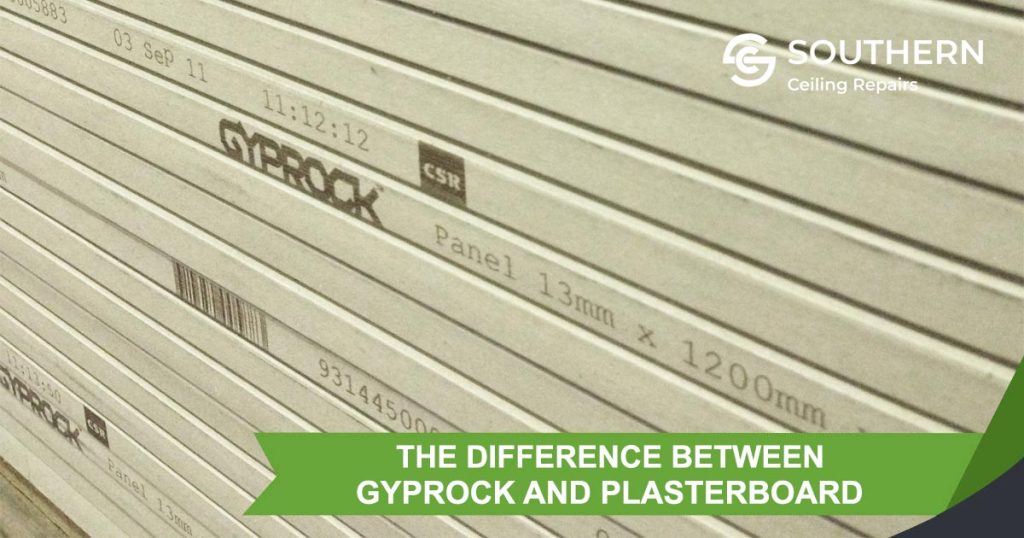
In the construction world, you might hear people talk about plasterboard vs gyprock interchangeably, which can be confusing. But here’s the deal: they’re the same thing with slight variations.
Gyprock is a brand name for plasterboard, kind of like how we say “Esky” for any cooler or ice box. So basically, they are the same thing with view differences.
Both materials are used for walls and ceilings, made from gypsum plaster pressed between two layers of paper. So, whether you call it gyprock or plasterboard, you’re talking about a fundamental building material that serves the same purpose.
What is Plasterboard?
Plasterboard, also known as gypsum board or drywall, is essentially a type of board crafted from gypsum, a soft mineral that’s crushed into a powder. Mix that powder with water, pour it into moulds, let it dry, and voila – you’ve got plasterboard!
This stuff is a staple in construction, used to build walls, ceilings, and partitions.
What is Gyprock?
Now, when we talk about gyprock, we’re referring to a specific brand of plasterboard made by the Gyprock company. Picture the same gypsum powder, the same process, but with a special touch from the folks at Gyprock.
It’s lighter, easier to install, and just a tad different from your run-of-the-mill plasterboard. And if you’re down in Western Australia needing southern gyprock repair, We got you covered!
Difference Between Gyprock and Plasterboard
So, what’s the difference between gyprock and plasterboard? Well, let’s break it down:
1. Weight
Gyprock is like the featherweight champ of the construction world. It’s significantly lighter than traditional plaster, which makes it a breeze to carry around and slap onto walls or ceilings.
If you’ve got a big project on your hands, gyprock’s lighter load will save your back some serious strain.
2. Ease of Cutting
Imagine trying to slice through a birthday cake with a butter knife versus a chainsaw. That’s kinda like the difference between cutting gyprock and cutting traditional plasterboard.
Gyprock is just easier to work with, whether you’re using a saw, knife, or utility knife. It’s like butter but without the mess.
3. Durability
Now, both gyprock and traditional plasterboard can take a beating, but if we had to pick a winner in the durability department, traditional plasterboard might edge out gyprock – just a smidge. That said, we’re talking about a tiny difference here.
Both materials will hold up just fine over time.
4. Soundproofing
When it comes to keeping noise at bay, gyprock has a bit of an edge over traditional plasterboard. If you’re building an apartment or a house with multiple units, gyprock’s superior soundproofing abilities make it a solid choice.
Your neighbours will thank you later.
Practical Applications
Now, let’s talk about where you can use gyprock and plasterboard:
Both materials are like the Swiss Army knives of construction – versatile and ready for action. You can use them to build walls, ceilings, and partitions in just about any space.
Plus, you’ve got options when it comes to finishing touches. Whether you prefer paint, wallpaper, or tiles, gyprock and plasterboard can handle it all.
Addressing Common Concerns
Cracks in Gyprock Ceilings
Ah, the dreaded cracks in the ceiling. If you spot some tiny ones, you might be able to patch them up yourself with a bit of plaster and elbow grease.
But if those cracks start getting out of hand or you’re just not sure how to fix them, it’s time to call in the pros. Companies like Southern Ceiling Repairs specialise in repairing gyprock ceilings, no matter how big or small the cracks may be.
So, there you have it – the lowdown on gyprock vs plasterboard. While they might seem like two peas in a pod, there are subtle differences that can make all the difference in your construction project.
Whether you’re going for the lightweight convenience of gyprock or the tried-and-true durability of traditional plasterboard, both materials have their time to shine. So go ahead, pick your poison, and let the building begin!
